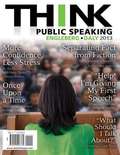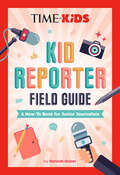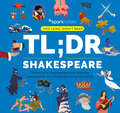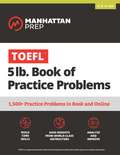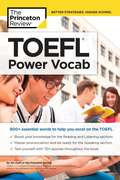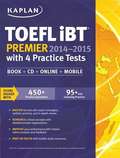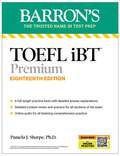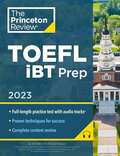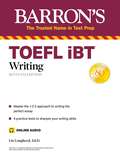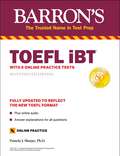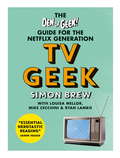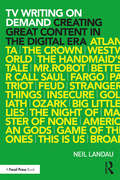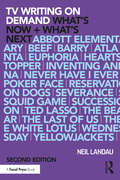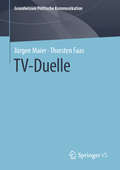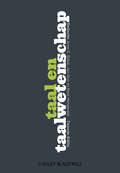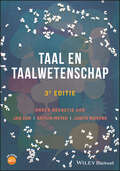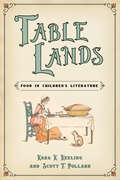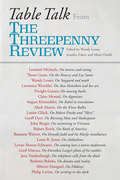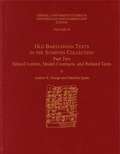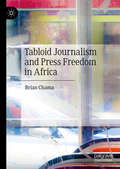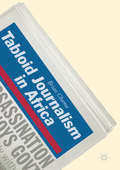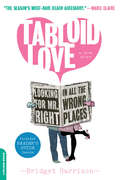- Table View
- List View
THINK: Public Speaking
by John Daly Isa N. EnglebergTHINK Public Speaking is a lively, accessible treatment of the core concepts of public speaking, filled with practical advice and examples and grounded in theory and research.THINK Public Speaking provides students with all the essentials for speaking successfully in the classroom and beyond.
TIME for Kids: A How-To Book for Junior Journalists (TIME for Kids)
by Hannah Rose HolzerLearn how to be a junior journalist with this TIME For Kids Field Guide!This field guide teaches you how to write many types of articles across several different sections including News, Opinion, Reviews, Arts and Culture, Sports, and more! Learn how to be a journalist in this book that explains how to interview sources, cover sports events, critique restaurants, write features on impactful people, and create great articles. This guide also features biographies on several famous journalists throughout history, including Ida B. Wells and Nellie Bly. Providing reliable sources for parents and educators for over 25 years, the TIME for Kids field guide is an excellent gift for young readers who want to learn more about the world and how to write about it.
TL;DR Shakespeare: Dynamically illustrated plot and character summaries for 12 of Shakespeare's greatest plays (Too Long; Didn't Read)
by SparkNotesThis refresher reference volume features concise character and plot summaries for 12 of Shakespeare&’s best-known plays, drawn from the SparkNotes website and illustrated with colorful infographics. Each of the 12 chapters in this volume runs 6 to 8 pages of text taken from the SparkNotes website, and is illustrated with colorful infographics for easy consumption. The 12 plays featured—six comedies and six tragedies—are among the most famous and most taught of Shakespeare&’s dramas, including Hamlet, King Lear, Macbeth, Romeo and Juliet, The Taming of the Shrew, The Merchant of Venice, Othello, and Julius Caesar.
TOEFL 5lb Book of Practice Problems: Online + Book
by Manhattan PrepManhattan Prep’s TOEFL 5 lb. Book of Practice Problems is an essential resource for students of any level who are preparing for the TOEFL. With more than 1,500 questions across 46 chapters in the book and in online resources, TOEFL 5 lb. provides students with comprehensive practice. Developed by our expert instructors, the problems in this book are sensibly grouped into practice sets and mirror those found on the TOEFL in content, form, and style. Students can build fundamental skills in Reading, Listening, Speaking and Writing through targeted practice, while easy-to-follow explanations and step-by-step processes help cement their understanding of the concepts tested on the TOEFL. In addition, students can take their practice to the next level with online question banks that provide realistic, computer-based practice to better simulate the TOEFL test-taking experience. Purchase of this book includes access to additional online resources and practice.
TOEFL Power Vocab: 800+ Essential Words to Help You Excel on the TOEFL
by Princeton Review800+ WORDS TO HELP YOU EXCEL ON THE TEST OF ENGLISH AS A FOREIGN LANGUAGE!• Boost your knowledge for the Reading and Listening sections• Master pronunciation and be ready for the Speaking section• Test yourself with 70+ quizzes throughout the bookImproving your vocabulary is one of the most important steps you can take to feel more confident about the Test of English as a Foreign Language. The Princeton Review's TOEFL Power Vocabulary has the words, tools, and strategies you need to help boost your comprehension levels and improve your score, including:• 800+ frequently-appearing TOEFL exam words • In-context examples and secondary definitions that help focus your study sessions• Mnemonic devices and root guidelines that expand your vocabulary• Brief vocab sections that break down content and let you work at your own pace• Quick quizzes with varied drills (definitions, word pairs, synonyms, antonyms, and more) to help cement your knowledge• Final drill section at the end of the book so you can assess your progress
TOEFL iBT Premier (Fifth Edition)
by The Editors at the Kaplan PublishingThis book is a comprehensive TOEFL program with full-length practice tests.
TOEFL iBT Premium with 8 Online Practice Tests + Online Audio, Eighteenth Edition (Barron's Test Prep)
by Pamela J. Sharpe Ph.D.Barron&’s newest edition of TOEFL iBT has been fully updated to reflect the new TOEFL format and provides flexible study options and key skills review to help you study what you need to know for the test. This edition includes: 8 full-length TOEFL iBT practice tests that reflect the most recent test format with answer explanations Comprehensive review of required academic and language skills Four video lessons on the key skills needed to succeed on the TOEFL: Note Taking, Paraphrasing, Summarizing, and Synthesis Grammar review that supports the Speaking and Writing Sections Online audio for all listening prompts
TOEFL iBT Prep (The Princeton Review)
by The Princeton The Princeton ReviewPrinceton Review Toefl Ibt Prep With Audio/listening Tracks 2023
TOEFL iBT Writing (Barron's Test Prep)
by Lin Lougheed Ph.D.TOEFL iBT Writing prepares students to succeed on the TOEFL's Independent Task, the all-important essay question, and on the Integrated Task, which combines reading, listening, and writing skills.The author presents a three-step program designed to help students write like native speakers of English. His coaching entails gathering ideas, organizing details, and developing the chosen topic into clear, grammatical written English. He also provides exercises in proofreading and editing. Model essays and model integrated tasks are included for students to read and analyze. Audio lectures typical of those presented on actual tests are included online.Lin Lougheed presents a three-step program designed to help students write like native speakers of English. The three steps include:Gathering ideasOrganizing detailsDeveloping the chosen topic into clear, grammatical written EnglishThe book also provides:Exercises in proofreading and editingModel essays and integrated tasks to read and analyzeOnline audio lectures similar to those presented on actual testsPublisher's Note: Products purchased from Third Party sellers are not guaranteed by the publisher for quality, authenticity, or access to any online entitlements included with the product.
TOEFL iBT: with 8 Online Practice Tests (Barron's Test Prep)
by Pamela J. Sharpe Ph.D.Barron&’s newest edition of TOEFL iBT has been fully updated to reflect the new TOEFL format and provides flexible study options and key skills review to help you study what you need to know for the test. You&’ll also get 8 full-length practice tests, 8 one-hour practice tests, four video lessons, online PowerPoint presentations, and online audio files for all the practice to help you feel prepared on test day.This edition includes:Eight full-length TOEFL iBT practice tests with answer explanations in both the book and online8 one-hour practice testsA review of required academic and language skills with four video lessons and a grammar review that supports the Speaking and Writing SectionsAn online pronunciation guide that features over 200 campus flashcards with vocabulary terms and example sentencesMP3 audio files online for all promptsA general overview of the TOEFL iBTPowerPoint review presentations with handouts and resources for tutors and teachers
TV Geek: The Den of Geek Guide for the Netflix Generation
by Simon BrewEssential nerdtastic reading! - Jason IssacsFrom the author of Den of Geek, this is the ultimate, nerdy television guide for TV geeks everywhere!TV Geek recounts the fascinating stories of cult-classic series, reveals the nerdy Easter eggs hidden in TV show sets, and demonstrates the awe-inspiring power of fandom, which has even been known to raise TV series from the dead. Includes:- How the live-action Star Wars TV show fell apart- The logistics and history of the crossover episode- The underrated geeky TV shows of the 1980s- The hidden details of Game of Thrones- Five Scandinavian crime thrillers that became binge hits - The Walking Dead, and the power of fandomTV series are now as big as Hollywood movies with their big budgets, massive stars, and ever-growing audience figures! TV Geek provides an insightful look at the fascinating history, facts and anecdotes behind the greatest (and not-so-great) shows.
TV Geek: The Den of Geek Guide for the Netflix Generation
by Simon BrewTV Geek recounts the fascinating stories of cult-classic series, reveals the nerdy Easter eggs hidden in TV show sets, and demonstrates the awe-inspiring power of fandom, which has even been known to raise TV series from the dead. Subjects include:- How the live-action Star Wars TV show fell apart- The logistics and history of the crossover episode- The underrated geeky TV shows of the 1980s- The hidden details of Game of Thrones- Five Scandinavian crime thrillers that became binge hits - The Walking Dead, and the power of fandomTV series now have the same budgets, stars, audience figures and cultural impact as Hollywood movies, and TV Geek provides an insightful look at the fascinating history, facts and anecdotes behind the greatest (and not-so-great) shows.This is the ultimate, nerdy television guide for TV geeks everywhere.
TV Writing On Demand: Creating Great Content in the Digital Era
by Neil LandauTV Writing On Demand: Creating Great Content in the Digital Era takes a deep dive into writing for today’s audiences, against the backdrop of a rapidly evolving TV ecosystem. Amazon, Hulu and Netflix were just the beginning. The proliferation of everything digital has led to an ever-expanding array of the most authentic and engaging programming that we’ve ever seen. No longer is there a distinction between broadcast, cable and streaming. It’s all content. Regardless of what new platforms and channels will emerge in the coming years, for creators and writers, the future of entertainment has never looked brighter. This book goes beyond an analysis of what makes great programming work. It is a master course in the creation of entertainment that does more than meet the standards of modern audiences—it challenges their expectations. Among other essentials, readers will discover how to: Satisfy the binge viewer: analysis of the new genres, trends and how to make smart initial decisions for strong, sustainable story. Plus, learn from the rebel who reinvented an entire format. Develop iconic characters: how to foster audience alignment and allegiance, from empathy and dialogue to throwing characters off their game, all through the lens of authenticity and relatability. Create a lasting, meaningful career in the evolving TV marketplace: how to overcome trips, traps and tropes, the pros and cons of I.P.; use the Show Bible as a sales tool and make the most of the plethora of new opportunities out there. A companion website offers additional content including script excerpts, show bible samples, interviews with television content creators, and more.
TV Writing On Demand: What's Now + What's Next.
by Neil LandauThis book takes a deep dive into writing for today’s audiences, against the backdrop of a constantly evolving TV ecosystem.The aim of this 2nd edition is to go beyond an analysis of what makes exceptionally compelling episodic TV series work. It is a master course in the creation of entertainment that does more than meet the standards of modern audiences – it challenges their expectations.The book will help readers discover how to satisfy the satiated viewer, by analyzing the new hybrid genres, trends, and how to make smart initial decisions for a strong, sustainable story. It will also cover the development of iconic characters that foster empathy and entice viewers to bond with characters and generate the sensation that their problems are mutual.Finally, the book will also take a deep dive into creating a lasting, meaningful career in the TV marketplace, by overcoming trips, traps and tropes, the pros and cons of IP, the use of pitch documents, pitch decks, and show “bibles” as proof-of-concept in the marketplace.This will be an essential resource for student and professional writers and is supplemented with a companion website offering additional content, including script excerpts, pitch document/deck/show bible samples, scene analysis and templates, plus useful writing exercises to break new ground and to mine new territory.
TV-Duelle (Grundwissen Politische Kommunikation)
by Thorsten Faas Jürgen MaierTV-Duelle sind ein fester Bestandteil und zugleich das wichtigste Einzelereignis in modernen Wahlkämpfen. Sie werden von Millionen von Zuschauerinnen und Zuschauern gesehen und umfassend in Massenmedien, aber zunehmend auch in den neuen Medien begleitet. Das vorliegende Buch gibt einen Überblick über Geschichte, Nutzung, Inhalte und Wirkungen von TV-Duellen. Im Fokus stehen dabei vor allem TV-Duelle in Deutschland. Der InhaltTV-Duelle in modernen Wahlkämpfen • Debattenforschung, aber wie? • Geschichte, Verbreitung und Varianten von TV-Duellen • Debatteninhalte und Debattenstrategien • Nutzung von TV-Duellen: Umfang, Rezipientenmerkmale und -motive • Wahrnehmung von TV-Duellen und Wahrnehmung des Debattensiegers • Wirkung von TV-Duellen • Kommunikation über TV-Duelle • Was gibt es nach 60 Jahren Debattenforschung noch zu untersuchen?Die AutorenProf. Dr. Jürgen Maier ist Professor für Politische Kommunikation an der Universität Koblenz-Landau. Seine aktuellen Arbeitsschwerpunkte liegen in den Bereichen Politische Kommunikation, Wahlen und politische Einstellungen sowie Einsatz experimenteller Designs bei der Untersuchung sozialwissenschaftlicher Fragestellungen.Prof. Dr. Thorsten Faas leitet die Arbeitsstelle "Politische Soziologie der Bundesrepublik Deutschland" am Otto-Suhr-Institut für Politikwissenschaft an der Freien Universität Berlin. Seine Arbeitsschwerpunkte liegen im Bereich von Wahlen, Wahlkämpfen und Wahlstudien.
Taal en Taalwetenschap
by Anne E. Baker Jan Don Kees HengeveldDit boek geeft een brede introductie in de taalwetenschap in al haar facetten. De structuur van taal krijgt uiteraard ruime aandacht, maar ook de taalgebruiker en de taalgemeenschap komen uitgebreid aan bod. • Voorbeelden uit een groot aantal talen. • Niet theorie-gebonden. • Geschikt voor probleem-gestuurd onderwijs. • Docentenhandleiding beschikbaar op beveiligde website.
Taal en Taalwetenschap
by Jan DonDe nieuwste editie van de toonaangevende bestseller in de categorie studieboeken Nederlandse taal en taalkunde In de derde herziene editie van Taal en Taalwetenschapgeefteen team van gerenommeerdetaalkundigeneen bredeinleiding inde belangrijkste thema'svan de taalwetenschap. Dit studieboek behandeltalle taalkundige deelgebieden, waaronderfonetiek, fonologie, morfologie, syntaxis, semantiek, discourse, en pragmatiek. De lezer maakt kennis met fundamentele begrippen en inzichten in het vakgebied, dieop toegankelijke wijze worden toegelicht aan de hand van voorbeelden uit allerlei talen. Ook is er aandacht voor meer toegepaste onderwerpen waarbij de taalgebruiker en taalgemeenschap centraal staan, zoalstaalverwerving, sociolinguïstiek, historische taalkunde en taalstoornissen. Deze jongste editie is grondig herzien om recente ontwikkelingen in het vakgebied recht te doen. Zo wordt de bespreking van taalverwerking versterkt door interdisciplinair onderzoek uit de neuro- en computerwetenschappen, en komen nieuwe inzichten vanuit de Optimaliteitstheorie en ander fonologisch onderzoek aan bod. In het boek kunnen lezers niet alleen zelftests vinden, maar ook: Uitgebreide introducties aan taal en taalvermogen om de lezer te gronden in noodzakelijke fundamentele kennis van het vakgebied Beschouwingen van discourse, syntaxis, woorden, fonologie, talen, en taalgemeenschappen Een toegankelijke schrijfstijl en vele voorbeelden om de betrokkenheid van de lezer te stimuleren, ideaal voor hen die nieuw met het onderwerp zijn Nieuwe oefeningen en samenvattingenen een begeleidende website die aanvullende onderwijsmaterialen voor de docent bevat, zoals modelantwoorden, onderwijssuggesties en aanvullende audio- en videobestanden Taal en Taalwetenschap is bij uitstek geschikt voor gebruik ininleidende cursussen in de taalwetenschap, maar ook voor zelfstudie: de bestseller is een onmisbaar naslagwerk dat een breed overzicht geeft van taal en taalwetenschap in al haar facetten.
Table Lands: Food in Children's Literature (Children's Literature Association Series)
by Kara K. Keeling Scott T. PollardFood is a signifier of power for both adults and children, a sign of both inclusion and exclusion and of conformity and resistance. Many academic disciplines—from sociology to literary studies—have studied food and its function as a complex social discourse, and the wide variety of approaches to the topic provides multidisciplinary frames for understanding the construction and uses of food in all types of media, including children’s literature. Table Lands: Food in Children’s Literature is a survey of food’s function in children’s texts, showing how the sociocultural contexts of food reveal children’s agency. Authors Kara K. Keeling and Scott T. Pollard examine texts that vary from historical to contemporary, noncanonical to classics, and Anglo-American to multicultural traditions, including a variety of genres, formats, and audiences: realism, fantasy, cookbooks, picture books, chapter books, YA novels, and film. Table Lands offers a unified approach to studying food in a wide variety of texts for children. Spanning nearly 150 years of children’s literature, Keeling and Pollard’s analysis covers a selection of texts that show the omnipresence of food in children’s literature and culture and how they vary in representations of race, region, and class, due to the impact of these issues on food. Furthermore, they include not only classic children’s books, such as Winnie-the-Pooh, but recent award-winning multicultural novels as well as cookbooks and even one film, Pixar’s Ratatouille.
Table Talk: From the Threepenny Review
by Wendy Lesser Jennifer Zahrt Mimi ChubbTable Talk is a portable dinner party and a book to read alone while laughing out loud. Table Talk is a salon attended by your smartest friends and by all of the wittiest people they know. <P><P>Table Talk is a collection of brief but critically acclaimed, half serious/half tongue-in-cheek pieces that borrow the format of The New Yorker's "Talk of the Town" column. Selected from several decades of The Threepenny Review, known colloquially as the West Coast's New York Review of Books, these anecdotal essays debate the historical, artistic, and technological developments of our time.Released to coincide with the 35th anniversary of The Threepenny Review in January 2015, Table Talk, edited by Wendy Lesser, Mimi Chubb and Jennifer Zahrt, includes essays by Christopher Ricks, who unfolds a dazzling literary history of the phrase "Table Talk"; Leonard Michaels on why the waltz should be viewed as an aggressive, imperialist dance; and Claire Messud on the art of digression in fiction and conversation. Sigrid Nunez engages with the contemporary vogue for memoir and autobiography, while Luc Sante draws conclusions about postmodern art from a stray bit of graffiti glimpsed on a New York street. Other contributions include Alexander Nehamas on the NEA controversy that roiled the culture wars of the 1990s and Paula Fox's tips for interacting with difficult children.Ninety-nine pieces become a garden of literary delights, as Table Talk takes an irreverent walk on the wild side of philosophical and cultural speculation that will resonate with readers of any age.
Tablets from the Iri-saĝrig Archive (CUSAS)
by Marcel Sigrist Tohru OzakiWhile each of the previously known archives from the Third Dynasty of Ur has provided distinct views of Sumerian society, those from Iri-Saĝrig present an extraordinary range of new sources, depicting a cosmopolitan Sumerian/Akkadian city unlike any other from this period. In this publication, Marcel Sigrist and Tohru Ozaki present more than two thousand newly identified tablets, mostly from Iri-Saĝrig. This unique and extensive corpus elucidates the importance that Iri-Saĝrig represented politically, militarily, and culturally in Sumer.Although these tablets were not able to be cleaned, baked, or photographed, the authors’ transliterations are based on the original tablets, often after repeated collations. Moreover, access to so many well-preserved tablets made it possible to improve upon the readings and interpretations offered in previous publications. Volume 1 contains a catalog and classification of the texts by provenance, a list of month names and year formulas, another of inscriptions, a chronological listing of the texts, and extensive indexes of personal names, deities, toponyms, and selected words and phrases. Volume 2 presents the texts in transliteration with substantial commentary.This two-volume publication preserves and makes available to the scholarly community a significant segment of Iraq’s cultural legacy that otherwise might have been ignored or even lost. It will augment and enhance our understanding of the unique civilization of Mesopotamia in the late third millennium BCE.
Tablets from the Irisaĝrig Archive (CUSAS: Cornell University Studies in Assyriology and Sumerology #40)
by Marcel Sigrist Tohru OzakiWhile each of the previously known archives from the Third Dynasty of Ur has provided distinct views of Sumerian society, those from Iri-Saĝrig present an extraordinary range of new sources, depicting a cosmopolitan Sumerian/Akkadian city unlike any other from this period. In this publication, Marcel Sigrist and Tohru Ozaki present more than two thousand newly identified tablets, mostly from Iri-Saĝrig. This unique and extensive corpus elucidates the importance that Iri-Saĝrig represented politically, militarily, and culturally in Sumer.Although these tablets were not able to be cleaned, baked, or photographed, the authors’ transliterations are based on the original tablets, often after repeated collations. Moreover, access to so many well-preserved tablets made it possible to improve upon the readings and interpretations offered in previous publications. Volume 1 contains a catalog and classification of the texts by provenance, a list of month names and year formulas, another of inscriptions, a chronological listing of the texts, and extensive indexes of personal names, deities, toponyms, and selected words and phrases. Volume 2 presents the texts in transliteration with substantial commentary.This two-volume publication preserves and makes available to the scholarly community a significant segment of Iraq’s cultural legacy that otherwise might have been ignored or even lost. It will augment and enhance our understanding of the unique civilization of Mesopotamia in the late third millennium BCE.
Tabloid Journalism and Press Freedom in Africa
by Brian ChamaThis book studies tabloid journalism newspapers within the broader context of press freedom in Africa. After defining tabloid journalism and professional practices within various political contexts, the book then proceeds to consider tabloids in Southern Africa and emerging cyberspace laws. Many factors of press freedom are considered, including the impact of public order and national security laws on tabloids in North Africa, the impact of defamation laws on tabloids in West Africa, the impact of the fake news laws on tabloids in East Africa, and the impact of sedition and treason laws on tabloids in Central Africa. Exploring tabloid journalism and press freedom in Arabic, Portuguese, and Francophone speaking countries across Africa, this book is a unique addition to this emerging field. The book concludes by providing a synthesis of the developing patterns from the cases analysed and by looking to the future to make recommendations and map the challenges and the successes.
Tabloid Journalism in Africa
by Brian ChamaBrian Chama provides a timely and important summary of tabloid journalism in Africa, which clearly shows how tabloids in the African context play a unique role in the democratization process. Prior to this book, very little was known about how tabloid journalists operate in Africa. The book first explores the global practice of journalism and then focuses on tabloid journalism - finally situating the discussion within the African context. As well as concentrating on how tabloid journalism can be seen as part of the broader neo-liberal thinking in Africa, in which democracy and freedom of expression is promoted, it also looks at how tabloid journalism practice has been met with resistance from the alliance of forces. Chama draws on examples from across the continent looking at success stories and struggles within the sometime infotainment genre. Tabloid Journalism in Africa concludes that even though challenges exist, there is a strong case to suggest that the practice of tabloid journalism is being readily accepted by many people as part of the unique voices of democracy - even those which might be shocking yet true.
Tabloid Love: Looking for Mr. Right in All the Wrong Places
by Bridget HarrisonDubbed one of the summer’s hottest beach reads by People, Glamour, Cosmo, and the Weekend "Today” show, Tabloid Love introduces Bridget Harrison, an almost thirty-year-old Brit and rookie reporter for the New York Post. While her London friends begin to marry, Bridget chases her dream of becoming a hard-news journalist. But just as she perfects the art of interviewing strangers about ghoulish crimes, she discovers that finding a mate seems impossible in the ultimate singles city. Then Bridget lands her very own Post dating column, and half a million New Yorkers read about her weekly romantic disasters. Whether covering celebrity parties in the Hamptons or struggling to hide her inter-office crush, Bridget retains such humor and humility "you’ll not only root for her, you’ll wish she were your best friend. ” (Harper’s Bazaar)
